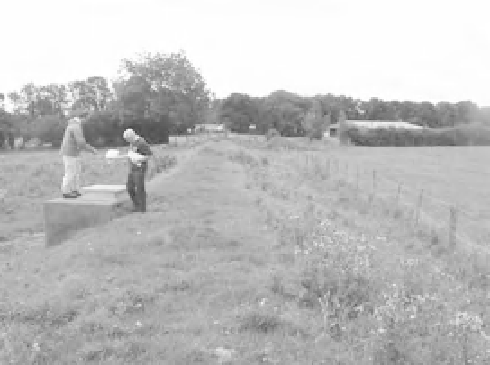Environmental Engineering Reference
In-Depth Information
checks for any signs of slope movement or mis-
alignment. Cracking without movement or mis-
alignment is ignored under this PF and would be
picked up under the 'cracking and/or fissuring'
PF. Movement of the slope with the appearance
of cracking parallel to the crest is a sign of
instabilities deep within the embankment and
is graded more severely than where cracking is
not evident.
Case Study
To demonstrate proof of concept for the work, a
number of case studies were selected. These were
principally based on assets used to train potential
inspection staff for the Environment Agency.
Images are provided by John Chatterton Associ-
ates and the Middlesex University Flood Risk
Hazard Research Centre. One of these case studies
is now described to illustrate the condition index-
ing method.
The case study presented is an earth embank-
ment that forms a section of the Shardlow ring
bank in Derbyshire. The nature of the ring bank
means that the asset is only subject to any hy-
draulic load under extreme conditions (at times of
high water levels). This enables the visual inspec-
tion process to be carried out easily with both
slopes and toes of the embankment visible under
normal conditions. Due to its infrequent use as a
flood defence and its position some distance from
the watercourse, the asset is subject to some un-
usual third-party activity. Livestock grazing on
the field in front of the inner slope have used the
flood defence for access to the field leading to some
damage to crest and slope (Figs 6.9 and 6.10). Also,
a drain has been placed in the inner slope (as seen
in Figs 6.8 and 6.11).
Fig. 6.8
Embankment length and view along crest.
the outer slope is overgrown and has therefore
been classified as grade 2. PF 7 has been given a
confidence of
1 to indicate the assigned condi-
tion of 4 (poor) is uncertain and could actually be
a 3 (fair). This is due to the fact that it is difficult
to determine if the deformation is definitely
caused by slope instability or is due to other
factors.
Step 2: calculation of failure mode indices
Table 6.3 shows the failure mode indices calcu-
lated. The table shows that 'slope instability' is the
FI with the highest value indicating that this is the
Step 1: assessment of performance features
The assessment of performance features used in
the Case Study is shown in Table 6.2. The em-
bankment is in relatively poor condition because
of the damage caused by third parties and foreign
objects as shown in the images. Vegetation on
Fig. 6.9
Rutting of embankment crest and slope caused
by third party (livestock).


